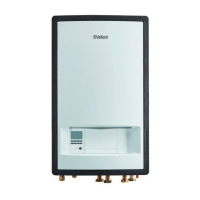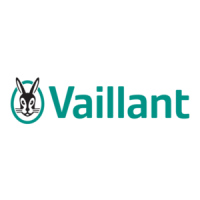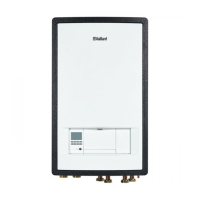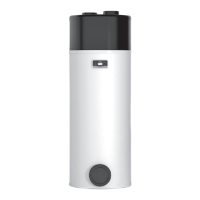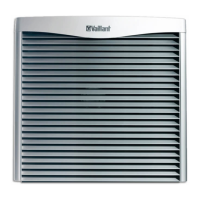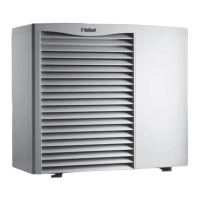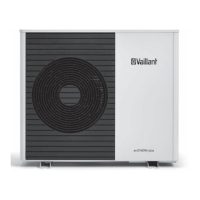Do you have a question about the Vaillant VWL 77/5 IS and is the answer not in the manual?
Classification and symbols for danger severity.
Specifies product usage and permissible combinations.
General guidelines for safe operation and product use.
Hazards from incorrect or missed maintenance procedures.
Hazards from contact with escaping refrigerant.
Environmental impact of R410A and proper disposal.
Overview of the display, buttons, and symbols.
Explanation of symbols used on the control panel.
How soft keys and buttons function within menus.
Shows current status and daily energy yield.
Explains the two operating levels (end user/competent person).
Views current product status information.
Importance of maintaining correct water pressure.
Adjusting the temperature for the heating circuit.
Adjusting the temperature for domestic hot water.
Requirements for annual and biennial inspections.
Interpreting and responding to maintenance alerts.
How to monitor and maintain heating circuit pressure.
How to interpret error codes displayed by the product.
Using tables to diagnose and resolve common issues.
Guidelines for environmentally sound disposal.
Procedures for handling refrigerant during disposal.
Terms and conditions for product warranty.
Section dedicated to diagnosing and resolving faults.
Details of user-accessible settings and parameters.
Hazards from touching live components and safety precautions.
Various safety functions integrated into the product.
Criteria for choosing a suitable location for installation.
Instructions for securely connecting refrigerant lines.
Safety precautions before electrical work.
Steps to connect the product to the electrical mains.
Initial activation of the heat pump system.
Ensuring water quality and proper treatment.
Guided setup process for system components.
Steps for filling and removing air from the heating system.
Activating and configuring the auxiliary heater.
Ensuring protection against legionella bacteria.
Monitoring the pressure in the heat pump circuit.
Final checks before handing over the product.
Adjusting parameters for optimal system performance.
Interpreting error codes displayed on the unit.
Accessing a log of recent faults.
General principles of inspection and maintenance.
Procedures for handling refrigerant during disposal.
General performance specifications of the product.
Schedule of required maintenance tasks and intervals.
Interpreting maintenance alerts and suggested remedies.
List of error codes and their causes/remedies.
List of error codes and their causes/remedies.
Checklist for verifying proper installation and commissioning.
Classification and symbols for danger severity.
Specifies product usage and permissible combinations.
General guidelines for safe operation and product use.
Hazards from incorrect or missed maintenance procedures.
Hazards from contact with escaping refrigerant.
Environmental impact of R410A and proper disposal.
Overview of the display, buttons, and symbols.
Explanation of symbols used on the control panel.
How soft keys and buttons function within menus.
Shows current status and daily energy yield.
Explains the two operating levels (end user/competent person).
Views current product status information.
Importance of maintaining correct water pressure.
Adjusting the temperature for the heating circuit.
Adjusting the temperature for domestic hot water.
Requirements for annual and biennial inspections.
Interpreting and responding to maintenance alerts.
How to monitor and maintain heating circuit pressure.
How to interpret error codes displayed by the product.
Using tables to diagnose and resolve common issues.
Guidelines for environmentally sound disposal.
Procedures for handling refrigerant during disposal.
Terms and conditions for product warranty.
Section dedicated to diagnosing and resolving faults.
Details of user-accessible settings and parameters.
Hazards from touching live components and safety precautions.
Various safety functions integrated into the product.
Criteria for choosing a suitable location for installation.
Instructions for securely connecting refrigerant lines.
Safety precautions before electrical work.
Steps to connect the product to the electrical mains.
Initial activation of the heat pump system.
Ensuring water quality and proper treatment.
Guided setup process for system components.
Steps for filling and removing air from the heating system.
Activating and configuring the auxiliary heater.
Ensuring protection against legionella bacteria.
Monitoring the pressure in the heat pump circuit.
Final checks before handing over the product.
Adjusting parameters for optimal system performance.
Interpreting error codes displayed on the unit.
Accessing a log of recent faults.
General principles of inspection and maintenance.
Procedures for handling refrigerant during disposal.
General performance specifications of the product.
Schedule of required maintenance tasks and intervals.
Interpreting maintenance alerts and suggested remedies.
List of error codes and their causes/remedies.
List of error codes and their causes/remedies.
Checklist for verifying proper installation and commissioning.
